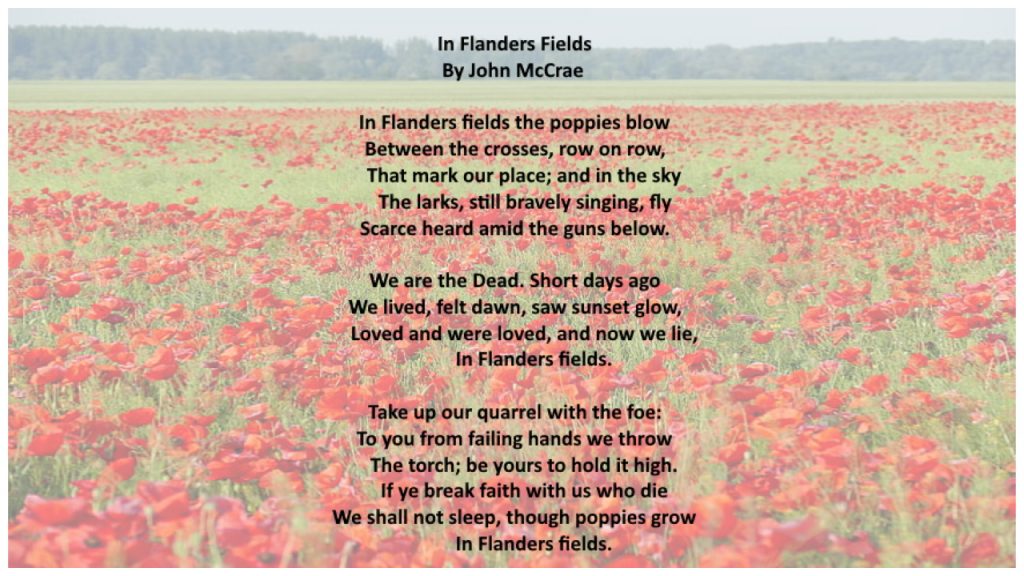On November 11, 1918, President Woodrow Wilson signed the agreement that ended the fighting in World War 1, a conflict that engulfed 30 nations and cost millions of lives (estimates vary). In June of 1919, the Treaty of Versailles would attempt to forge the terms of the peace. Months later, on November 11, 1919, Wilson led America’s first celebration of Armistice Day. He declared that on the “eleventh hour in the eleventh day of the eleventh month,” arms were officially laid down. Wilson said, “To us in America, the reflections of Armistice Day will be filled with solemn pride in the heroism of those who died in the country’s service and with gratitude for the victory, both because of the thing from which it has freed us and because of the opportunity it has given America to show her sympathy with peace and justice in the councils of the nations…" (“History of Veterans Day,” https://www.va.gov/opa/vetsday/vetdayhistory.asp).
Congress declared Armistice Day a federal holiday in 1938. Ironically, The ceremony on November 11, 1938 in the United States coincided with the press reports of “Kristallnacht” coming from Germany. That infamous event launched by Hitler’s Nazi regime on November 9-10 of 1938 destroyed Jewish-owned businesses and homes, killed or maimed many German Jews (and others), and burned synagogues and schools. Many historians cite Kristallnacht as the catalyst for intensification of hate-filled anti-Semitism that eventually led to the murder of 6 million Jews in the Nazi regime’s holocaust and genocide period. Sadly, a recent Pew study showed how few younger Americans know this history. Furthermore, Pew found rampant ignorance among younger Americans when it comes to the entire period surrounding WW1 and WW2.
The original Armistice Day designation continued through WW2 and the Korean War. It wasn’t until 1954 that Armistice Day became Veterans Day and was broadened in scope to honor all US veterans of all wars. The distinction between Memorial Day and Veterans Day is this: While Memorial Day honors those who died in battle or from wounds they suffered, Veterans Day honors not only those dead but also those who served and survived. See these links for more of this history: https://www.almanac.com/veterans-day, https://www.defense.gov/Explore/Features/story/Article/1675470/5-facts-to-know-about-veterans-day/, and https://www.va.gov/opa/vetsday/vetdayhistory.asp. Canada celebrates November 11, too, but they call it Remembrance Day. The UK also celebrates a National Service of Remembrance on the Sunday nearest to November 11 (https://en.wikipedia.org/wiki/Remembrance_Day).
There was a span of years in the US, from 1971 to 1978, when, under the Uniform Holiday Bill, Veterans Day was celebrated not on the 11th but on a Monday, as Washington's Birthday, Memorial Day, and Columbus Day still are, with all four holidays affording federal employees three-day weekends to recreate and to travel. But moving the date from November 11 to an adjacent Monday met with widespread disapproval, given the enormous historical significance of the November 11 date. Veterans rejected the change as commercialism. In 1975, President Gerald Ford signed a bill that would return Veterans Day to its rightful spot on the calendar three years later (“History of Veterans Day,” https://www.va.gov/opa/vetsday/vetdayhistory.asp). So, in our national history, Armistice Day/Veterans Day is a hallowed remembrance celebrated precisely on November 11th.
On this day, we once again wear our symbolic poppies and remember our veterans who fought in wars throughout our country’s history. We strive to honor them. Let’s offer five reflective inspirations.
1. “In Flanders Fields” is a war poem in the form of a rondeau, written during the First World War by Canadian physician Lieutenant-Colonel John McCrae. He was inspired to pen it on May 3, 1915, after presiding over the funeral of friend and fellow soldier Lieutenant Alexis Helmer, who died in the Second Battle of Ypres. According to legend, fellow soldiers retrieved the poem after McCrae, initially dissatisfied with his work, discarded it. “In Flanders Fields” was first published on December 8 of that year in the London magazine Punch. The poem inspired the tradition of wearing a red poppy for Veterans Day in remembrance of those who served. I try revisit this poem every year and share it often, as readers know, recalling memories and reflections. (The source for the commentary above and for the poem printed below is https://www.poetryfoundation.org/poems/47380/in-flanders-fields.)
2. In 1975, Scottish folk singer-songwriter Eric Bogle visited one of those poppy fields in France that McCrae wrote of in his poem. He remembers that day:
“When I was in Northern France in 1975, I stopped at a small Battalion cemetery near the Belgian border. It was a beautiful little spot, very peaceful, the sun was shining and poppies grew in the fields. It was so beautiful that one could almost forget the Great Obscenity that had murdered the 310 soldiers lying buried in that cemetery. Almost, but not quite. I wrote this song two months later.”
The song, “The Green Fields of France,” invites us to reflect upon and honor the short life of a young soldier whose grave Bogle encountered in the lush field, amid red flowers and white stones.


